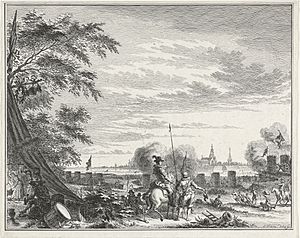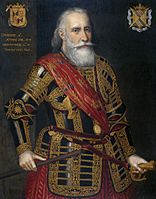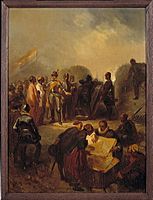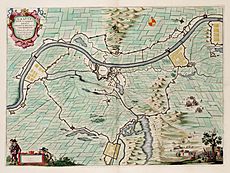Siege of Grave (1602) facts for kids
Quick facts for kids Siege of Grave (1602) |
|||||||
|---|---|---|---|---|---|---|---|
| Part of the Eighty Years' War & the Anglo–Spanish War | |||||||
 Siege of Grave in 1602 from a print by Simon Fokke |
|||||||
|
|||||||
| Belligerents | |||||||
| Commanders and leaders | |||||||
| Strength | |||||||
| 20,000 | 1,500 (Grave), 8,000 (Spanish relief army) |
||||||
| Casualties and losses | |||||||
| Unknown | ~1,000 captured | ||||||
The Siege of Grave was a military event that happened from July 18 to September 20, 1602. It was a key part of two bigger wars: the Eighty Years' War and the Anglo–Spanish War. During this time, a city called Grave in the Netherlands was controlled by Spain.
A combined army from the Dutch Republic and England surrounded Grave. This army was led by Maurice of Orange and Francis Vere. After almost two months of fighting, the city gave up. This happened after a Spanish army, sent to help Grave, was defeated outside the city. This loss was so bad for the Spanish that it caused a huge mutiny among their soldiers.
Contents
Why the Siege Happened
Prince Maurice of Orange was a Dutch leader. He was fighting against the Spanish armies in the southern parts of the Netherlands. His goal was to take back control of cities held by Spain. He wanted to keep the Spanish busy at Ostend, where they were trying to capture a city. This would allow him to take other Spanish-held towns.
Maurice had already captured Rheinberg, an important Spanish stronghold on the Rhine river, in July 1601. Meanwhile, the English commander Francis Vere had successfully defended Ostend from a large Spanish attack.
Vere Joins Maurice
The Dutch government wanted Vere to join Maurice in the field. So, Vere left Ostend in March 1602. His troops were replaced by fresh soldiers. Vere then joined Maurice's army with about 8,000 English soldiers. Many of these soldiers were experienced fighters from the siege at Ostend.
Maurice and Vere gathered their forces, which totaled almost 20,000 men. They marched into the heart of Brabant. Maurice first tried to move towards Tienen. However, the Spanish commander Francisco López de Mendoza had set up strong defenses. Maurice decided not to attack Mendoza directly. He also did not want to leave a large Spanish force behind him.
So, Maurice changed his plan. He turned his army back north. He decided to besiege either Grave or Venlo. In the end, Grave was chosen.
Grave's Defenses
Grave was an important town located on the Maas river. It had been captured by the Spanish in 1586. Since then, it had been under Spanish control. The city's defenses were very strong. They had been improved over time. Grave was completely surrounded by field fortifications. This meant a direct attack would be very difficult.
The Siege of Grave Begins
By mid-July, the Dutch and English armies reached Grave. The English soldiers, led by Sir Francis Vere, were on the right side. The center was led by Count William Louis. The left side was commanded by Count Ernest of Nassau.
The city of Grave was defended by over 1,500 Spanish and Italian soldiers. Their commander was Don Antonio Gonzalez. They hoped to hold out for more than two months. They expected a relief army to arrive and help them.
Digging In
On July 18, the Anglo-Dutch force surrounded Grave. They quickly started digging trenches and building siege works around the city. The defenders tried to bring in more soldiers, but it was too late. Grave was completely cut off.
The Dutch and English siege positions were very large. Each small fort, called a redoubt, had its own water-filled ditch and a drawbridge. It took almost five hours to walk all the way around their siege lines.
Spanish Relief Attempt
The Spanish soldiers inside Grave hoped for help from nearby Venlo. Francisco Mendoza arrived there with a Spanish force in late July. Mendoza tried to relieve Grave. However, he soon found out how large the Dutch and English army was. The leading Spanish soldiers ran into strong defenses and were pushed back.
The soldiers inside Grave heard that Mendoza was close. They tried to attack the besieging army several times. These attacks, called sallies, were not successful. They wasted men and supplies. The sallies stopped when they heard that Mendoza's troops had to go back to Venlo in late August. Also, some Spanish soldiers started to mutiny, which means they rebelled against their commanders.
Vere's Injury
During the Spanish relief attempt, Francis Vere was checking the English trenches. Heavy fighting broke out when the Spanish launched a sally. The Spanish were pushed back. However, Vere was badly hurt. A bullet went through his head, just below his eye, and got stuck in his skull.
This injury meant Vere could not fight for the rest of the war. The bullet was removed, and he rested. He was not able to return to the battlefield until the end of the year. Because Vere was wounded, Frederick Henry, who was only eighteen, took over his command. Vere's brother, Horace Vere, took charge of the English troops in the field.
Grave Surrenders
In early September, the besiegers faced a new problem. Heavy rains caused the water levels in the Maas river to rise quickly. The water rose so fast that Maurice even thought about ending the siege. He considered making a quick retreat. He also called for the Grave soldiers to surrender.
Luckily for Maurice, the Grave soldiers were in a very bad situation. On September 20, Don Antonio Gonzalez accepted Maurice's terms and surrendered. The Spanish had no choice. They were suffering from diseases, rising waters, and a severe lack of food. They also knew that their relief force had been turned back, which led to a large mutiny.
-
Envoys from the Aceh Sultanate visit Maurice at Grave
After the Siege
After sixty days, the siege was over. The Spanish army was allowed to leave Grave with their weapons and flags. The Dutch and English armies proudly entered Grave the next day.
On September 28, Maurice was made the count of the region in Grave. This happened in a building that had been given to his father, William of Orange, in 1559.
Spanish Mutiny
Because the Spanish failed to break the siege, a mutiny broke out among their troops. They were angry about not being paid. About 1,200 soldiers left their posts in Venlo. They captured a town called Hamont and then fled to Hoogstraten. Other Spanish troops followed them. Eventually, the mutineers made a deal with Maurice. As part of the deal, Grave was to be held by the mutineers before being returned to Dutch control by the end of 1603.
Maurice also heard that the Spanish siege at Ostend was not going well. The next year, 1603, was a time of uncertainty for both Maurice and the Dutch government. Also, Queen Elizabeth I of England died, and King James I of England became king. This put military operations on hold. The Dutch leader Johan van Oldenbarnevelt had talks with the English court and parliament. However, these talks did not lead to much.
The fighting started again in 1603. Ostend was still under siege. Maurice managed to retake Wachtendonk in March 1603. He also captured Sluis in the Southern Netherlands in August 1604. Despite heavy losses, the Spanish forces did not give up on Ostend. It finally surrendered in September 1604.
Grave remained under Dutch control for the rest of the war. English soldiers mostly guarded it until 1648.




